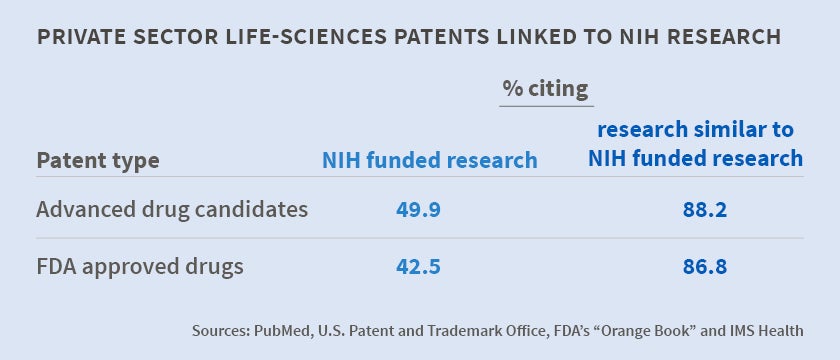NIH Funding Spurs Private Patenting
An additional $10 million in NIH funding generates 3.1 additional private-sector patents in the research area that receives the funding.
The National Institutes of Health (NIH) is the largest funder of biomedical research in the United States. A perennial question about the NIH, and other government bodies that fund research, is what are the societal and medical benefits of all this government-funded research? Pierre Azoulay, Joshua S. Graff Zivin, Danielle Li, and Bhaven N. Sampat provide new evidence on the links between such research funding and innovation.
In Public R&D Investments and Private-Sector Patenting: Evidence from NIH Funding Rules (NBER Working Paper No. 20889), the authors find that NIH funding of biomedical research leads to increased biomedical patenting by firms without crowding out private investment in other research areas.
One of the challenges to evaluating the productivity of government-supported research is establishing direct links between specific research projects and specific results, such as cure of a disease or development of a new blockbuster drug or medical device. As other researchers and the authors have noted, scientific research usually doesn't follow a straight path from laboratory to a publicly acknowledged success. Research into one disease may have a beneficial effect on treatment of a completely different disease years after the original research project is completed. Public-sector and private-sector scientists often build on the prior research of others, creating a complicated genealogy of projects which may have contributed to successful outcomes.
In their study, the authors examined NIH funding of biomedical research projects from 1980 through 2005 and sought to quantify the impact of that funding on the rate of patent production by pharmaceutical and biotechnology firms. They created an entirely new "bibliometric" database which allowed them to link NIH grants that had been cited in publications to patent applications that specifically cited those publications. This approach allowed the authors to track the often-circuitous path from NIH funding to subsequent patentable innovations. Using publication citations and NIH project data, they also could measure whether NIH funding crowded out private research efforts.
The authors find that NIH funding increases total private-sector patent activity. One of their central estimates suggests that an additional $10 million in NIH funding generates 3.1 additional private-sector patents in the same research area, or approximately one patent for every two NIH grants.
With regard to patents associated with U.S. Food and Drug Administration-approved biopharmaceutical products, one set of the authors' calculations suggests that $1 of NIH funding leads to between 70 cents and $2.13 in lifetime pharmaceutical sales. These estimates based on drug sales do not take into account other potentially important benefits from NIH investment, including the consumer benefits from these drugs, the development of other patented technologies such as medical devices, and the development of other non-patented technologies such as new clinical protocols.
There are apparently substantial "spillover effects" from one research project to the next. The researchers find that about half of the patents resulting from NIH funding are for application to a disease different from the one targeted in the initial research.
"The size of this effect underscores the importance of our approach to linking patents with funding," the authors write. "By looking only within the same disease area when measuring impact, the prior literature in this area may miss almost half of the total impact of basic science funding."
The study does not find any decrease in patenting activity by private companies in research areas not covered by NIH grants. "This suggests that NIH funding spurs private patenting by increasing total firm R&D expenditure," the authors write.
-- Jay Fitzgerald



